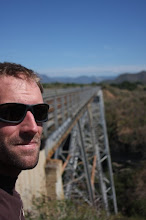 At dusk, an SF30C clears into the north end of the Patio Norte at Tierra Blanca. The town is quiet except for the distant sounds of boxcars being switched, music playing in nearby houses and children playing baseball in the street.
At dusk, an SF30C clears into the north end of the Patio Norte at Tierra Blanca. The town is quiet except for the distant sounds of boxcars being switched, music playing in nearby houses and children playing baseball in the street. The quiet is broken by a southbound unit cement train slowly passing through yard limits, blasting the whistle over the many residential street crossings on the north side of town. The yard job has cleared out to let the road train by.
The quiet is broken by a southbound unit cement train slowly passing through yard limits, blasting the whistle over the many residential street crossings on the north side of town. The yard job has cleared out to let the road train by.
 Having just returned from switching at Tuxtepec, Oaxaca, a former AT&SF SF30C pauses at the South Yard at Tierra Blanca.
Having just returned from switching at Tuxtepec, Oaxaca, a former AT&SF SF30C pauses at the South Yard at Tierra Blanca.  Earlier in the day, a yard job is switching the small yard at Papaloapan. They have pulled off the branch from Tuxtepec, and will pick up a few cars from the small yard before returning to Tierra Blanca. The SF30C is one of two that remain on the Ferrosur roster. Made from U36C's, the Santa Fe custom made the unique cabs and noses on 70 such locomotives. Several were eventually sold to FNM. However, only two remain in Mexico, both on Ferrosur's roster. Number 9530 is preumably still wearing the same number used while on the Santa Fe.
Earlier in the day, a yard job is switching the small yard at Papaloapan. They have pulled off the branch from Tuxtepec, and will pick up a few cars from the small yard before returning to Tierra Blanca. The SF30C is one of two that remain on the Ferrosur roster. Made from U36C's, the Santa Fe custom made the unique cabs and noses on 70 such locomotives. Several were eventually sold to FNM. However, only two remain in Mexico, both on Ferrosur's roster. Number 9530 is preumably still wearing the same number used while on the Santa Fe. At Tres Valles, Veracruz, I wanted to photograph the northbound quimico as it crested this short grade. But just as the train got close, my autofocus picked up on this guy walking across the tracks. Walking back to town from the sugarcane fields with his blade across his shoulder, I immediately thought he was more interesting than the train.
At Tres Valles, Veracruz, I wanted to photograph the northbound quimico as it crested this short grade. But just as the train got close, my autofocus picked up on this guy walking across the tracks. Walking back to town from the sugarcane fields with his blade across his shoulder, I immediately thought he was more interesting than the train.At Medias Aguas, a single Ferrosur engine rests on the south leg of the wye. This is the junction with the former FC Chiapas y Mayaba line to Salina Cruz and the Guatamala border. Although information is scarce, FIT is reportedly operating this line as far as Salina Cruz. However, there were several Ferrosur boxcars parked on the main track south of the wye with no indication of recent movement. The rails were rusted over, and dirt filled in the flangeways at all the crossings.
































 The Mexico City radio stations are
The Mexico City radio stations are 























